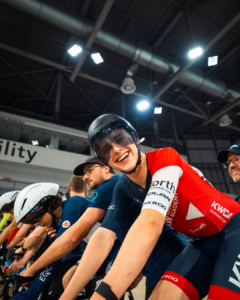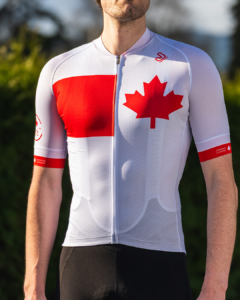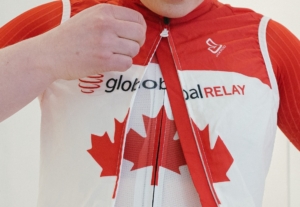THE ART OF CATCHING THE BREAKAWAY: UNDERSTANDING CHAPATTE’S LAW
By Kevin Field, Head of Performance Strategy at Cycling Canada
Cycling Canada was recently asked by a journalist to provide any insight we had on Chapatte’s Law for an article he was researching. To be honest, I had never heard it referred to this way, or if I had I’d forgotten. I had to look it up.
While I didn’t recognize the name, the principle of Chapatte’s Law is really well known in cycling and is definitely used by cycling teams all the time in race planning and during races. I have vague memories of Phil Liggett and Paul Sherwen talking about it during race coverage from the 90’s. It’s more a guide than a law and it essentially says that in a road race, the bunch will likely be able to chase down a breakaway at a rate of 1 minute every 10 kilometers.
You can also think of this as seconds per kilometer and I often refer to the following table:
| Speed | Time/km | Speed | Time/km |
| 20 kph | 3:00 | 40 kph | 1:30 |
| 25 kph | 2:24 | 42 kph | 1:26 |
| 30 kph | 2:00 | 45 kph | 1:20 |
| 35 kph | 1:43 | 47 kph | 1:17 |
| 37 kph | 1:38 | 50 kph | 1:12 |
When you look at this something stands out. At slower speeds the time difference per kilometer is significantly different and diminishes the faster you’re going, which makes sense.
Chapatte’s Law is 6 seconds per kilometre or the time difference between going 42kph and 45kph. These are reasonable speeds on undulating terrain for a break versus well organized, sustainable chase.
However, applying this guide too literally can lead to tactical mistakes. I thought it would be fun to look at how it actually works by looking at last year’s National Road Championship course and explaining how I might break down the course and explain sections and time to riders if I was directing a team.
I would break up the race into six sections. Assuming you had a team of seven to eight experienced athletes I would explain it this way:
- Breakaway
A small break will likely go in the first 15-30km. The smaller the better on this course. If a team chose not to put someone into the break, you would want to keep the break between 3-5 riders, any more than that you’d want to put a rider into it, or shut it down and re-shuffle.
Chapatte’s Law doesn’t really apply here.
- Control
The 15km circuit in Saint-Odilon is tricky to control on. Keep the break under 4 minutes, ideally 3:30. When a break is gone, the bunch can really lull… you need to be extremely careful when this happens, as going slow even for 2-3km can lead to giving away huge chunks of time that will be very difficult to bring back later in the race and/or put you too short of resources at the next key point of the race (section #4).
The Côte de l’Église climb on the circuit is too short to gain time back on a breakaway. Over the top there is a left turn onto an undulating section of twisty road. Depending on wind and other factors, this is an important part of course to manage counter attacks.
- Chase
Start chasing with just over 2 laps on the circuit to go. Chapatte’s Law would say you should be able to close 1:30 per lap, but in reality this is difficult because there is 4km of gentle descending on fast roads where the bunch and break will be going more or less the same speed. You can only count on closing 1:00 minute or less per lap on this circuit.
I would tell the team to get the gap under 2 minutes before the end of the last circuit. You want to be within 30-45 seconds of the break at the summit of Route Langevin (section #4). To do this, you need to exit the circuits with under 2 minutes, even ideally 1:30.
On this circuit you are chasing back slower than Chapatte’s Law.
- Smash
Your top riders have to smash the race apart on Route Langevin. It’s really hard for 2.5km, especially after 140-50km, and this is 4-5km in total. You can anticipate being able to close to 1:00-1:30 on a break that is likely starting to fall apart or has no “change of speed” after a long steady day.
During this 5km section, you are chasing back at double Chapattes Law, ideally.
- Manage/Feather
If it worked out, you have a small elite group and you have the breakaway in sight. Hold high/sustainable speed, do not allow any lulls in the pace… they will be deadly. Manage the gap at 30-45s. You can recover a bit from the Langevin effort, just don’t lull. Get your final bottle from the car and assess the situation with your sport director. Calling the car at this point is essential. The bunch will be in tatters and the commissaires will be barraging groups. You want your riders to call the car up for a feed so you can move ahead of the barrages and cover your top riders to the finish. Being able to service them and give them critical information is important as they manage the final 25km of the race.
There’s lots of downhill, and sections of really straight road (high visibility). With a hard-coordinated effort, a chase group can close the gap to a tiring break quickly in this section, especially since you will get some draft effect from the official car/moto behind the break. If your riders are confident, they don’t have to close to the break here.
Chapatte’s Law doesn’t really apply here. You have an approximately 20km section where you can be feathering the gap to the break. This can be really important because you want to set up the…
- Catch and counter
This section is where you MUST catch whatever is left of the break. At the end of this section there is quite a hard hill, which is a launch pad for a winning attack. You want to control this counter move so someone from your team makes the move and solos to a win. Or, you control an opponent’s move – cover and kill. You want to come into this section no more than 10-15 seconds behind whatever break is left. Your riders need to be really smart to manage this section and try to assess what the break may/may not have left as well as what your opponents in the chase have. You need two or more teammates in the group and it is important how they position in the group so you maximize visibility on your opponents. This is where all alliances in the chase group go away, the knives come out and the race is won or lost by how you play this 3-4km section.
As far as Chapatte’s Law, you should be able to close 15-20 seconds in 2.5km in this section leading to the final kicker. You are chasing back at double Chapatte’s Law.
If you are interested in learning more about Chapatte’s Law, click here.








